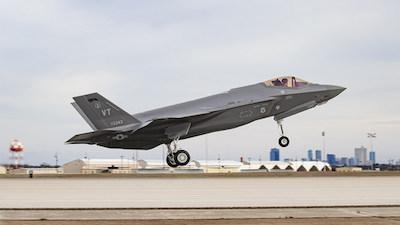Fri, Mar 15, 2024
After Years of Delays, the Lightning Graduates From Low-Rate Initial Production
The F-35 Lightning II, first taking to the skies in 2006, has finally been approved for full, genuine, actual showtime-ready mass production.

There are almost a thousand of the fighters out there in the wild already, but they've been built under provisionary Low-Rate Initial Production guidelines, limiting the scope of orders and allowing a little more variation until they could definitively identify the final mark to run with. It's a very delayed milestone, coming more than 20 years after the Joint Strike Fighter program really got to work on designing it, but it's finally come to pass. Years of teething issues and upgrade packages kept the F-35 on the waver wire, alternating between futuristic war-winner and caterwauling hangar queen. Right now, the Air Force is currently awaiting the rollout of Technology Refresh 3/TR-3 and the 4th block upgrade to the platform, which will hopefully iron out some of the irritations of the platform and modernize it with improved sensor suites, electronic warfare capabilities, and long-range strike accuracy.
Those who excitedly watched the development of the F-35 have had to watch a few faceplants along the way. The distinction of leaving LRIP isn't a tidal shift for the Lightning, since previous years have seen just as many aircraft produced as there would be under full production anyways. But it's a triumphant milestone for fans of the aircraft, though it's less a valedictorian and more a GED holder at this point. The Lightning has become undoubtedly capable by now - but it should be nothing but capable after 2 decades of development. Recent changes will improve it on many fronts, but they too will probably come with all new teething issues and problem-solving contracts. From now on, they can really let the production line fly, stamping out something north of 150 aircraft per year.
“This is a major achievement for the F-35 Program,” said Under Secretary for Acquisition and Sustainment William LaPlante. “This decision—backed by my colleagues in the Department—highlights to the Services, F-35 Cooperative Program Partners, and Foreign Military Sales customers that the F-35 is stable and agile, and that all statutory and regulatory requirements have been appropriately addressed. The F-35 Program is the premier system that drives interoperability with our allies and partners while contributing to the integrated deterrence component of our National Defense Strategy.”
More News
He Attempted To Restart The Engine Three Times. On The Third Restart Attempt, He Noticed That Flames Were Coming Out From The Right Wing Near The Fuel Cap Analysis: The pilot repor>[...]
Make Sure You NEVER Miss A New Story From Aero-News Network Do you ever feel like you never see posts from a certain person or page on Facebook or Instagram? Here’s how you c>[...]
From 2009 (YouTube Edition): Leading Air Show Performers Give Their Best Advice for Newcomers On December 6th through December 9th, the Paris Las Vegas Hotel hosted over 1,500 air >[...]
Aero Linx: NASA ASRS ASRS captures confidential reports, analyzes the resulting aviation safety data, and disseminates vital information to the aviation community. The ASRS is an i>[...]
“For our inaugural Pylon Racing Seminar in Roswell, we were thrilled to certify 60 pilots across our six closed-course pylon race classes. Not only did this year’s PRS >[...]
 NTSB Final Report: Rutan Long-EZ
NTSB Final Report: Rutan Long-EZ ANN FAQ: Turn On Post Notifications
ANN FAQ: Turn On Post Notifications Classic Aero-TV: ICAS Perspectives - Advice for New Air Show Performers
Classic Aero-TV: ICAS Perspectives - Advice for New Air Show Performers ANN's Daily Aero-Linx (06.28.25)
ANN's Daily Aero-Linx (06.28.25) Aero-News: Quote of the Day (06.28.25)
Aero-News: Quote of the Day (06.28.25)



